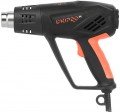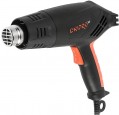Fan speeds
The number of fan speeds provided for in the adjustments of the heat gun. The intensity of blowing the workpiece, or rather the amount of air supplied and the pressure of the air flow, depends on the fan speed. And since different jobs require different intensities of air supply, the more speeds a hair dryer has, the more versatile it is, the easier it is to adjust its parameters for certain tasks. Most modern models have
2 – 3 speed adjustments, however, there are also very simple single-speed options, and even advanced devices with smooth adjustment, which allows you to select the fan speed as accurately as possible for a specific purpose.
Max. performance
The maximum amount of air that a heat gun can pass through during operation. The higher the performance (at the same temperature), the more intensively the workpiece can be heated and the better the hair dryer is suitable for large-scale work related to blowing large surfaces. On the other hand, high performance usually requires corresponding power, with all the ensuing consequences (see "Power consumption"), and the need for large volumes of air is not always there. Therefore, when choosing, you should not chase maximum performance — first of all, you need to take into account the specifics of the tasks for which you plan to use a hair dryer.
Temperature adjustments
The number of outlet air temperature adjustments provided for in the design of the heat gun. The adjustment itself is an almost mandatory function for such a tool — after all, different types of work and different types of materials require their own temperature values, and without it you can either “underheat” or “burn through” the workpiece. The more adjustments provided in the design of the hair dryer — the finer the temperature settings, the easier it is to choose the mode that is optimal for a particular task. At the same time, it is worth noting that in this case we are talking about
step temperature control, while the most advanced option today is smooth control (see below).
Minimum heating temperature
The lowest air temperature that a heat gun can produce when operating in normal mode, in other words, the lower limit of the operating temperature range. Accordingly, the lower this limit, the wider the range, ceteris paribus, and the more versatile the tool: after all, for different jobs and temperatures, you need different ones. Some modern hair dryers have the ability to "cold" blowing, without heating.
Max. heating temperature
The highest outlet air temperature that a hair dryer can provide. As with the minimum temperature, this parameter determines how wide the operating range of the tool is and for what range of work it can be used. High operating temperatures are important not only for refractory materials — they can significantly speed up the processing of large surfaces. On the other hand, it is worth considering that for strong heating, appropriate power is required, which affects the weight, energy consumption, and often the price of the hair dryer.
Stepples t° control
The ability
to smoothly change the temperature of the air supplied by the heat gun. The meaning of temperature adjustments is generally detailed in the relevant paragraph above; here we note that smooth adjustment has a number of advantages over stepped. The main one is that the outlet temperature in such hair dryers can be adjusted very precisely, and at will, and not in accordance with the fixed values \u200b\u200bthat are set in the manufacturer's settings. Among the disadvantages of this option, one can note a higher cost than most step regulators — despite the fact that in fact high tuning accuracy is not required so often, usually in professional work.
Cold air mode
This option allows you to completely turn off the heating element, leaving only the fan running, or reduce the heating temperature to a minimum of 50 °C.
The cold air mode is necessary for cooling heated parts. For example, a stream of cold air will allow you to quickly cool the seams of hot melt adhesive. Most often, the cold air mode is represented by a separate position on the temperature mode switch, while cold air will be carried out at one single speed. But some models allow you to turn off the heating element by hardware, in which case cold blowing can be carried out in a wide range of speeds.
Display
The presence of its own
display in the design of the heat gun. Usually, this is the simplest black-and-white LCD screen for 3-4 characters, sometimes with additional graphic indicators. However, even such a screen significantly increases the ease of management, making it more informative. Various additional data can be displayed on the display, both basic (temperature, fan speed, etc.) and auxiliary (for example, error notifications). At the same time, screens are inexpensive, so they can be found even in low-cost-level heat guns.

